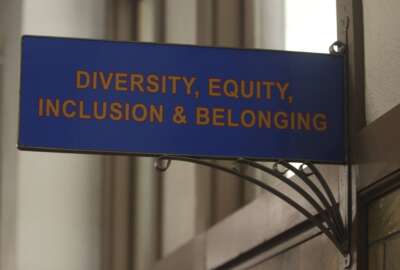Federal CIO VanRoekel details his ‘first’ priorities
Federal CIO Steven VanRoekel wants the government to move toward a share-first policy where agencies share IT before buying new. He also introduced his \"Future...
wfedstaff | June 4, 2015 1:09 pm
With nearly three months on the job, federal chief information officer Steven VanRoekel is putting a new shine on some long-standing technology priorities.
VanRoekel gave his first major policy speech on Tuesday night, since taking over for Vivek Kundra in August, signaling how he plans to move the administration’s IT reform ball forward.
“Building on the progress of the last two-and-a-half years, my focus going forward will be to drive innovation in government and make investments in technology that better serve the American people,” VanRoekel said during his speech at PARC headquarters during an event sponsored by TechAmerica and the Churchill Club in Palo Alto, Calif. “We will use technology to improve government productivity and lower barriers to citizen and business interaction with the government, all while bolstering cybersecurity.” 
Share first
Among his first efforts is to improve collaboration and coordination among agencies. The Office of Management and Budget will begin promoting a “share first” policy. VanRoekel said the idea is to have agencies look to others when buying technology or upgrading systems before going off on their own.
“We plan to work with our counterparts in procurement, in agencies and with Congress to drive this ability to share,” he said. “We can take advantage of lowering the cost structure and increasing the pace of implementation. If someone else procured the system or technology first, we are able to use it much faster.”
Along those same lines, VanRoekel is testing the use of tiger teams made up of experts to help agencies with specific technology needs and to help change the culture to one of taking risks similar to a start-up.
OMB also placed other experts, or entrepreneurs-in-residence at the Food and Drug Administration and the Department of Health and Human Services to try to promote the concept of taking risks, agile development and learning from mistakes. Frank Baitman, former Social Security Administration CIO, is at the FDA under this program.
Future first
VanRoekel said more help is on the way. The CIO Council received 5,000 applications for the Tech Fellows Program.
“I’m very encouraged by that number,” he said. “The amount of talent we can draw from is great. And talent and technology is a huge part of the equation.”
OMB said it expects these new fellows to come into agencies starting in January under the broader Presidential Management Fellows Program.
VanRoekel also is focusing efforts on contractors. He said agencies are testing vendor management organizations, which is a group of experts who look across the agency at investments and whether the vendors are meeting their goals and whether potential vendors are able to meet the agency’s needs.
All of this is a part of a large effort VanRoekel called Future First.
“Much as our cloud first policy changed the landscape of IT spending, Future First will jump-start the government’s adoption of new technologies and approaches. I envision a set of principles like XML First, Web Services First, Virtualize First and other ‘firsts’ that will inform how we develop our government’s systems,” he said. “They will effectively establish a new default setting for architecting solutions governmentwide, and they will be continuously updated as new technologies emerge to ensure that our government is at the frontier of advancements that yield a higher return on our IT investments, increase productivity, and improve the way the government interacts with the American people.”
VanRoekel said he is initially launching Future First as just an email address, futurefirst@cio.gov, but plans to move it into a crowdsourcing platform to gather insight from as many people as possible.
“I would love to start a dialogue on this about what should be included and what shouldn’t be,” he said. “I know we want to avoid stuff that can’t evolve or that locks us in to a vendor. Future First will always evolve.”
Future First also will include the continued push for agile software development, which is where the tiger teams and entrepreneurs-in-residence will help, he said.
VanRoekel said cybersecurity and mobile computing cuts across all of these areas.
He said innovation gives agencies the opportunity to improve their cybersecurity, while at the same time meeting customer expectations in delivering services.
“All of these elements are really grounded in the foundation that is cybersecurity,” he said. “It’s a part of everything we do. I think our general problem is people use cybersecurity as an excuse not to move forward on innovating. You can’t shift to the cloud because of cyber risks. Or don’t move to a new platform because of cyber risks. They are making a false choice between security and innovation. But they should dovetail into an opportunity for improvement.”
VanRoekel also said the government doesn’t have mobile strategy, but needs to make sure smartphones and tablets are part of the innovations agencies are considering.
To that end, VanRoekel said the administration’s cloud security standards, FedRAMP, continue to be in the final stages of development.
“We will start on the commodity side for things like email, but a big component and the secret sauce of FedRAMP is once we get enough vendors in place, we will require agencies who want to acquire cloud services to go through FedRAMP. Second, we worked with NIST to create an infrastructure for continuous monitoring. DHS will monitor the cyber footprint across the cloud landscape. Vendors who sign up for FedRAMP must adhere to continuous monitoring by DHS.”
Citizen engagement
In addition to the focus internally, VanRoekel said agencies need to take an external focus on how they interact with citizens.
The Obama administration — and the Bush administration — have spent a lot of time trying to get agencies to be more citizen centered, but both have found limited success.
So VanRoekel is pushing a “no wrong door” policy for citizens to interact with agencies.
“We for too long have relied on citizens to absorb the government’s complexity and we have not been an enabler, but an inhibitor,” he said. “We will shift to and deliver on promises to businesses to develop a one-stop portal called BusinessUSA.gov. It will be one place to get information on exporting and other business needs. It will entail lot of technology to pull information from many different agencies. We will co-brand everything so if you go to a Commerce site but you really needed to go to SBA’s, we will make it easy for the business to do that.”
The White House announced it would launch BusinessUSA.gov in September during MEDWeek.
VanRoekel said United Kingdom is just starting to such an effort to consolidate portals — one for businesses and one for citizens.
“It’s an interesting notion to think about for the federal government,” he said. “It’s something we could aspire to and promote the outside looking in mentality.”
RELATED STORIES:
New program aims to bring in new tech workers
White House wants to open channels for small businesses
Copyright © 2025 Federal News Network. All rights reserved. This website is not intended for users located within the European Economic Area.
Jason Miller is executive editor of Federal News Network and directs news coverage on the people, policy and programs of the federal government.
Follow @jmillerWFED






